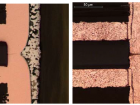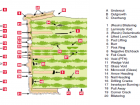The purpose of vibration tests is to evaluate the effect caused on component parts by vibration in a specified frequency range. The samples are subjected to testing under different conditions, as described below, in accordance with the respective applicable standards. The test conditions differ in terms of duration, frequency range, vibration waveform, amplitude, etc.
Our facilities enable us to perform all vibration testing specified by MIL standards, as follows:
Vibration Fatigue
Pure sine vibration. The sample is vibrated with a constant amplitude simple harmonic motion having a peak acceleration of 20g, 50g or 70g, depending on the test conditions (condition A, B, or C, respectively). This amounts to a long-term vibration since the motion is applied for 32±8 hours in each orientation X, Y and Z. The applicable documents are:
- MIL-STD-883 Method 2005 for integrated circuits
- MIL-STD-750 Method 2046 for semiconductor devices
Vibration Noise
Pure sine vibration. The electrical noise output is measured with the device under vibration, the vibration signal matching a simple harmonic motion with either an amplitude of 0.06 inch pk-pk or a constant peak acceleration of 20g. The vibration frequency is varied logarithmically from 20 to 2000 Hz, with one vibration cycle lasting for minimum 4 minutes and performed for each axis, X, Y and Z. This methodology is described in the following standards, where the requirements for the employed voltmeter are also detailed:
- MIL-STD-883 Method 2006 for integrated circuits
- MIL-STD-750 Method 2051 for semiconductor devices
The maximum inherent noise in the circuit should be at least 10dB below the specified noise‑output voltage.
Vibration, Variable Frequency
Pure sine vibration. This test is carried by applying simple harmonic motion vibration to the device, the motion having either a constant peak acceleration of 20g, 50g, or 70g, depending on the test conditions (condition A, B, or C, respectively) or a peak to peak amplitude of 0.06 inch. The test cycle consists of a frequency sweep from 20 to 2000Hz and back over the course of approximately 4 minutes. Four cycles are supposed to be applied to the device along each of the three axes, with single test duration thus reaching a minimum of 48 minutes. The applicable standards are:
- MIL-STD-883 Method 2007 for integrated circuits.
- MIL-STD-750 Method 2056 and 2057 (monitored) for semiconductor devices.
Vibration (Passive Components)
Pure sine vibration. This test is similar to the above with the test parameters modified as specified in MIL-STD-202G method 201A. The passive component is subjected to a simple harmonic motion with an amplitude of 0.06 inch pk-pk and the vibration frequency varying uniformly between 10 and 50Hz with approximately 1 minute sweep time up and down. Unless otherwise specified the motion is applied for 2 hours in each orientation, X, Y and Z, the total test time being 6 hours.
Vibration, High Frequency (Passive Components)
Pure sine vibration. This test is performed on passive components in accordance with MIL‑STD-202G method 204D. The test conditions described in this document include the specification of acceleration, amplitude, frequency range, etc. and are represented by the following figure:
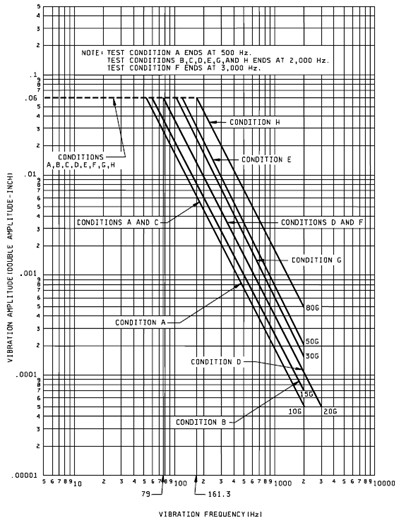
It is worth remarking that though the vibration that affects devices during their field service is not necessary a pure sine vibration, this kind of tests have proven sufficient for determining critical frequencies, modes of vibration and other data allowing to ensure the reliable response and performance of devices under vibration.
Random Vibration
Random vibration test reproduces in a more realistic manner the vibration affecting microcircuits in their service-field environments. The test allows to evaluate whether the component is able to withstand the dynamic stress caused by random vibration. This is a destructive test during which the entire frequency spectrum vibration is generated simultaneously in the value range determined by the test method (see the graphs below) and with the magnitude of a Gaussian (normal) amplitude distribution. Acceleration magnitudes of the peak values should not exceed three times the RMS so that the confidence level is higher than 99,9 %. Controlling the test signals in terms of power-spectral density provides a more reliable description of the energy distribution applied to the sample by considering the signal history, and is defined as follows:

Two possible test conditions, in accordance with the standard MIL STD 883 method 2026 (Integrated Circuits), are detailed below. The duration of random vibration is 15 minutes for each axis, X, Y and Z.
- Test condition I (MIL-STD-883 method 2026)
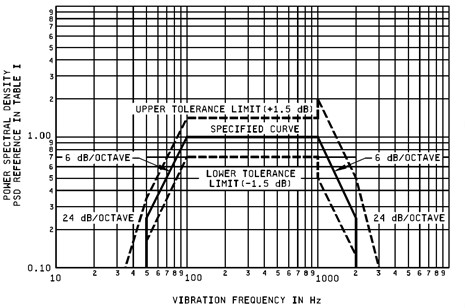
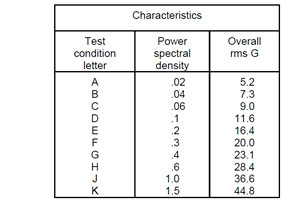
- Test condition II (MIL-STD-883 method 2026)
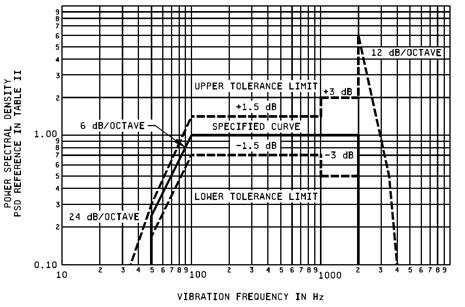
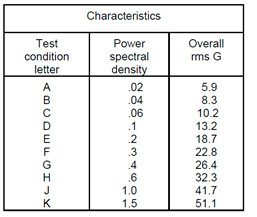
- Vibration Simulation and Analysis - 12th March 2019
- Vibration Tests on HI-ReL EEE Parts - 22nd January 2019
- Vibration Tests Electronic Parts - 20th January 2016



